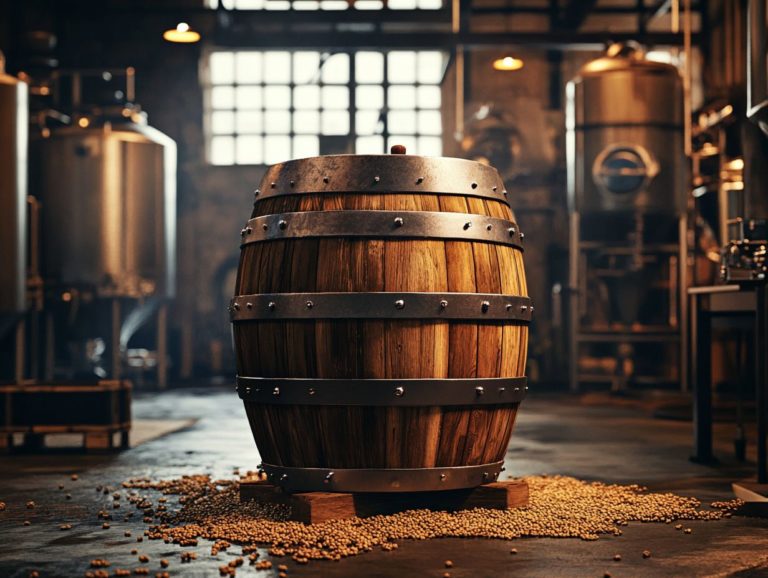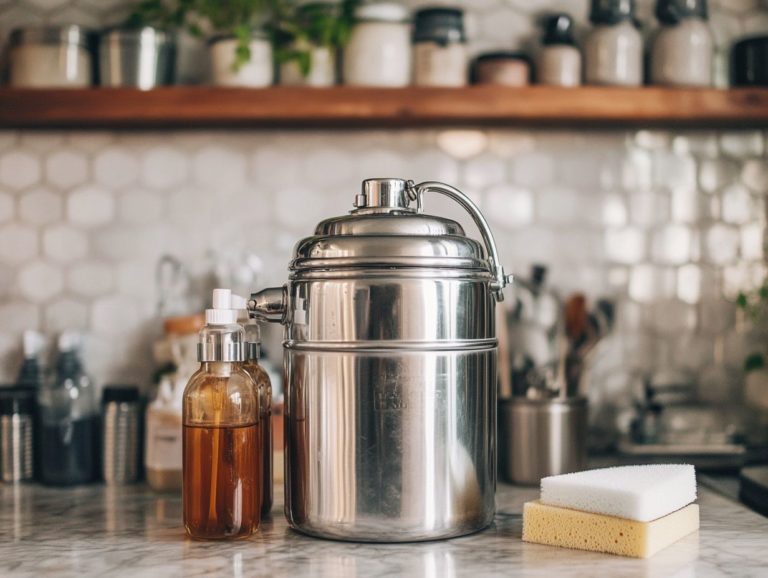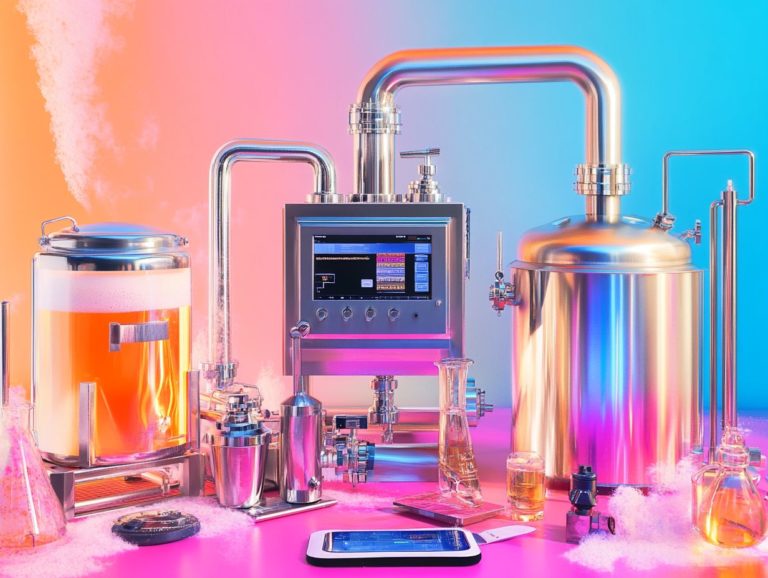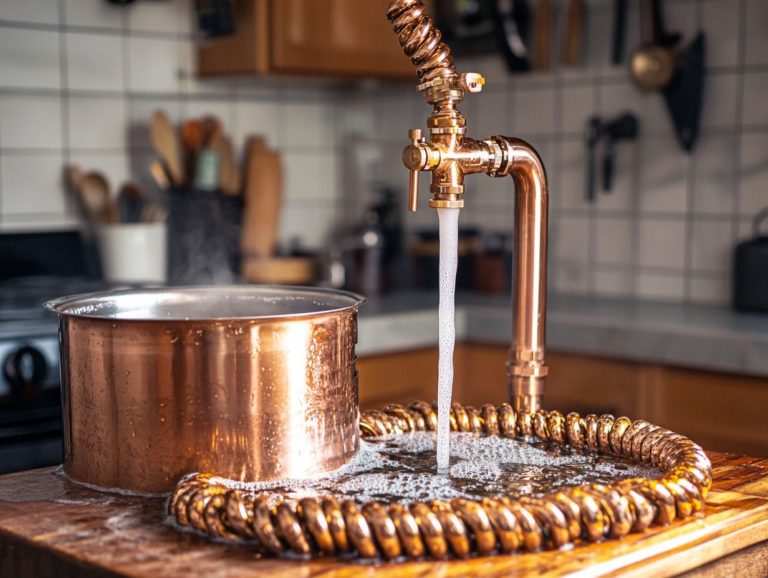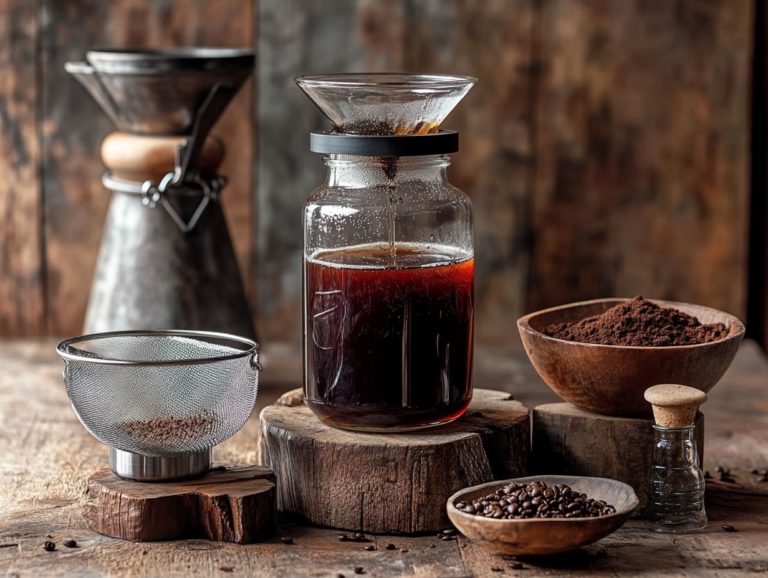How to Choose the Right Brewing Kettle
Brewing kettles are indispensable for any home brewer who is truly passionate about crafting their own beer, tea, or even coffee at home. With a variety of types available, including stainless steel, aluminum, copper, and electric options, selecting the right brew kettle can profoundly influence your brewing experience.
Considerations such as kettle material, brew kettle size, and features like spigot type and temperature control mechanisms are vital to your decision-making process. This guide shows you the different types of brewing kettles, highlights key factors to consider when choosing one, and provides maintenance tips, ensuring you make an informed choice that elevates your brewing adventures. It will help you choose the best brewing kettles for your specific needs, such as those suited for extract brewing or all-grain brewing.
Contents
- Key Takeaways:
- What is a Brew Kettle?
- Types of Brewing Kettles
- Factors to Consider When Choosing a Brewing Kettle
- What to Look for in a Good Brewing Kettle?
- How to Properly Maintain a Brewing Kettle?
- 3. Maintenance of Additional Features
- Frequently Asked Questions
- What factors should I consider when choosing a brewing kettle?
- How do I determine the right size of brewing kettle for my needs?
- What are the main materials used for brewing kettles and which one is best?
- This guide will help you choose the right brewing kettle by answering common questions.
- What features should I look for in a brewing kettle?
- Can I use any type of kettle for brewing beer?
- How much should I budget for a brewing kettle?
Key Takeaways:
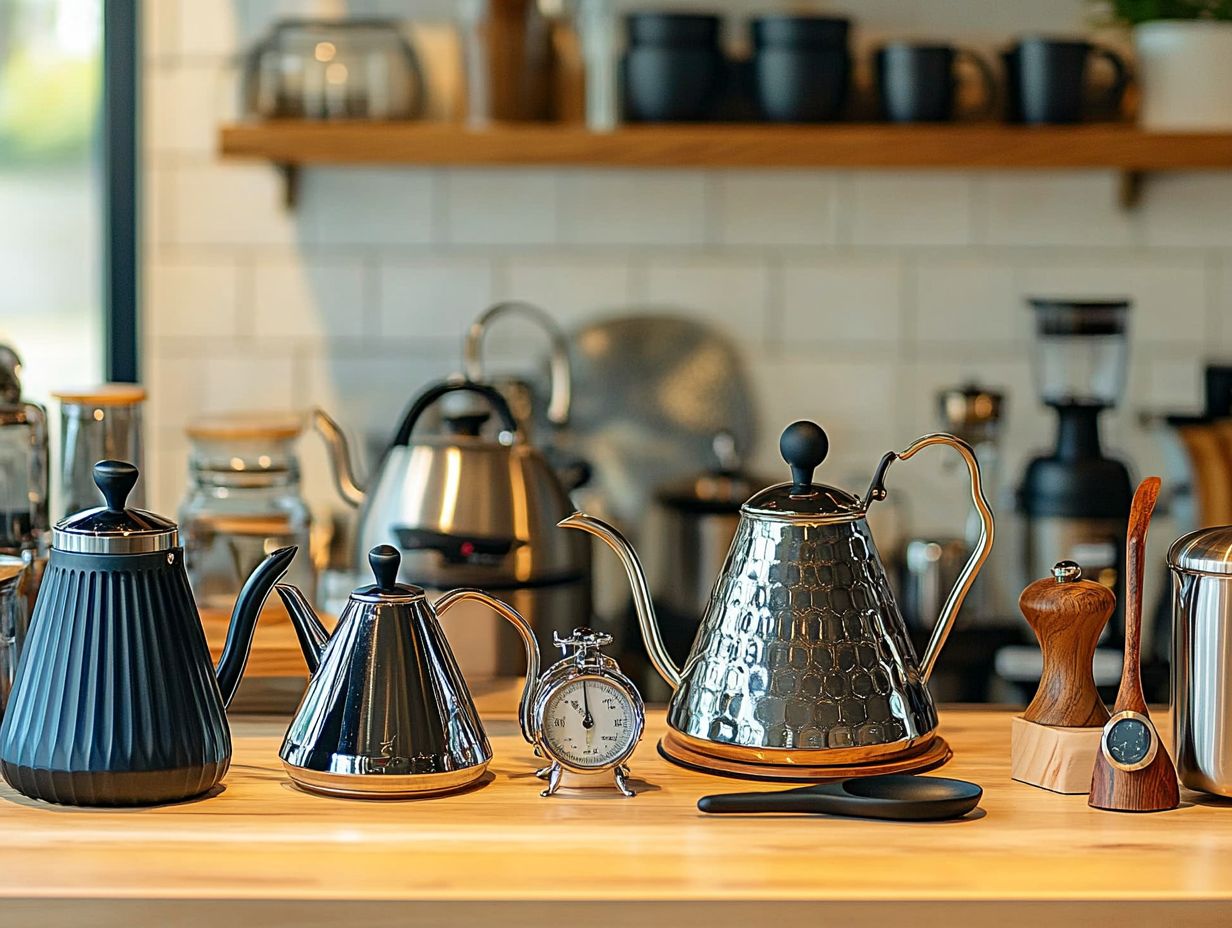
- Choose a brewing kettle with a material that suits your needs, whether it’s durable stainless steel, lightweight aluminum, or heat-conductive copper.
- Consider the capacity, heat source, and additional features of a brewing kettle before making a purchase.
- Maintain your brewing kettle by regularly cleaning it, storing it properly, and taking care of any additional features it may have.
What is a Brew Kettle?
A brew kettle is an essential tool for any home brewer. It acts as the vessel where the boiling liquid is crafted during the beer-making process. Its significance extends beyond mere utility; it fundamentally influences the quality of your brewing setup and can impact the flavor and stability of your beer.
Typically constructed from premium materials such as stainless steel, aluminum, or copper, these kettles boast a range of features designed to optimize temperature control, streamline liquid transfer, and promote a seamless brewing experience.
Choosing the right brew kettle is exciting and can transform your brewing adventures! The kettle you select can profoundly affect the flavor and stability of the final beer product. Choosing the right kettle features, like spigot type and built-in thermometers, can enhance your brewing process.
Types of Brewing Kettles
Brewing kettles are available in various types, each presenting unique advantages and features tailored to different brewing methods and personal preferences. Whether you’re into extract brewing or all-grain brewing, there’s a kettle designed to meet your specific needs.
As a home brewer, you might opt for stainless steel kettles, renowned for their durability and superior heat conductivity. Brands like Spike offer high-grade kettles that are a top choice for brewing enthusiasts.
Alternatively, aluminum kettles provide a lightweight option that suits those on a budget. However, be mindful of aluminum oxide buildup that can occur over time. If aesthetics are a priority, copper kettles are likely to catch your eye, thanks to their stunning appearance and excellent heat distribution.
For those who value convenience, electric kettles deliver precise temperature control that can elevate your brewing experience. Brands like Br u Supply offer innovative options like the Unibr u system, which is favored by many for its user-friendly design and effectiveness.
By understanding the distinctions among these brewing kettles, you can confidently choose the perfect option to fulfill your specific brewing needs. Whether you’re setting up your first brewing setup or upgrading your brewing equipment, the right brew kettle can make all the difference!
Start your brewing journey today by choosing the right kettle that meets your needs!
1. Stainless Steel Kettles
Stainless steel kettles are a top-tier choice for home brewers, and it s easy to see why. Their exceptional durability, resistance to corrosion, and low maintenance make them stand out.
These high-grade kettles offer outstanding heat conductivity, ensuring even boiling and precise temperature control throughout your brewing process. Whether you re a novice or an experienced brewer, the variety of sizes and spigot types available can cater to your specific needs.
Brands like Spike and Br u Supply provide excellent options for every brewer. Their sturdy construction allows them to handle high temperatures and frequent use without warping or degrading, extending their lifespan and providing a consistent brewing experience.
The smooth, non-porous surface of stainless steel is easy to clean often, a simple wipe with a damp cloth is all it takes to keep it looking pristine. Stainless steel is also resistant to aluminum oxide buildup, which can be an issue with other materials.
If you re setting up a brewing system, investing in a stainless steel kettle is essential. It plays a pivotal role in heat retention, crucial for extracting optimal flavors.
To maintain your kettle s top-notch condition, regularly check for limescale buildup and avoid abrasive cleaners that could damage its surface. This way, you ensure that it remains a reliable companion in all your brewing adventures. Many high-grade kettle options come with built-in thermometers and spigots to enhance your brewing process.
2. Aluminum Kettles
Aluminum kettles are an economical choice for home brewers, celebrated for their lightweight design and efficient heat distribution. They excel in providing excellent temperature control during the crucial boiling wort phase.
However, aluminum kettles can be more vulnerable to scratches and dents. The formation of aluminum oxide may require extra care during cleaning, so careful maintenance is essential to prolong their lifespan.
Despite these concerns, aluminum kettles remain a smart option for those starting their beer brewing journey. They boast remarkable heating properties, allowing for quick boiling times and even heat distribution, both vital for achieving consistent brewing results.
When considering your purchase, balance the affordability of aluminum kettles against their potential for rapid wear and tear. To ensure they last, focus on using non-abrasive cleaning tools and avoid sudden temperature changes that could warp the metal.
Brands like Spike and Br u Supply offer great options for aluminum kettles. Keeping your kettle dry and properly stored when not in use can help prevent oxidation, ensuring that your brew days remain enjoyable and efficient.
Regularly check for aluminum oxide buildup to preserve its efficiency and longevity.
3. Copper Kettles
Copper kettles are prized not just for their eye-catching beauty, but also for their exceptional heat distribution. They are the go-to choice for traditionalists and home brewers aiming for an elegant brewing setup.
These kettles elevate the aesthetic of your brewing equipment while delivering precise temperature control, crucial during the boiling wort process. Brands like Br u Supply offer high-quality copper kettles that blend functionality with stunning design.
Their remarkable heat conductivity ensures even cooking, significantly reducing the risk of hot spots that can scorch your precious ingredients. Beyond their practical advantages, the rich, warm hue of copper adds a touch of sophistication to any kitchen or brewing space.
To keep that lustrous exterior gleaming and to prevent oxidation, regularly polish the surface with a specialized copper cleaner. Rinse it immediately after use to prevent food residue from building up.
Following these care tips will ensure your copper kettle continues to impress both visually and functionally for years to come.
4. Electric Kettles
Electric kettles have become a favorite among home brewers, and it s easy to see why. With their convenience and programmable temperature settings, you gain precise control throughout the brewing process. These kettles come with built-in heating elements that can rapidly bring your wort (the liquid extracted from the malted grains during brewing) to a boil and maintain a consistent temperature, essential for achieving those optimal brewing results. Systems like Br u Supply’s Unibr u and HERMS offer advanced features that take electric brewing to the next level.
This level of precision is particularly advantageous, allowing you to hold specific temperatures for extended periods perfect for brewing specialty teas or delicate coffee varieties that demand exact brewing conditions. Unlike traditional stovetop kettles that require your undivided attention and can lead to overboiling or temperature fluctuations, electric kettles simplify the process, letting you focus on crafting the perfect brew.
Add in features like automatic shut-off and keep-warm settings, and you ll see why many are making the switch to this innovative, user-friendly appliance in their brewing routines. Brewing isn’t just a task; it’s an exhilarating journey that transforms your entire experience!
Factors to Consider When Choosing a Brewing Kettle
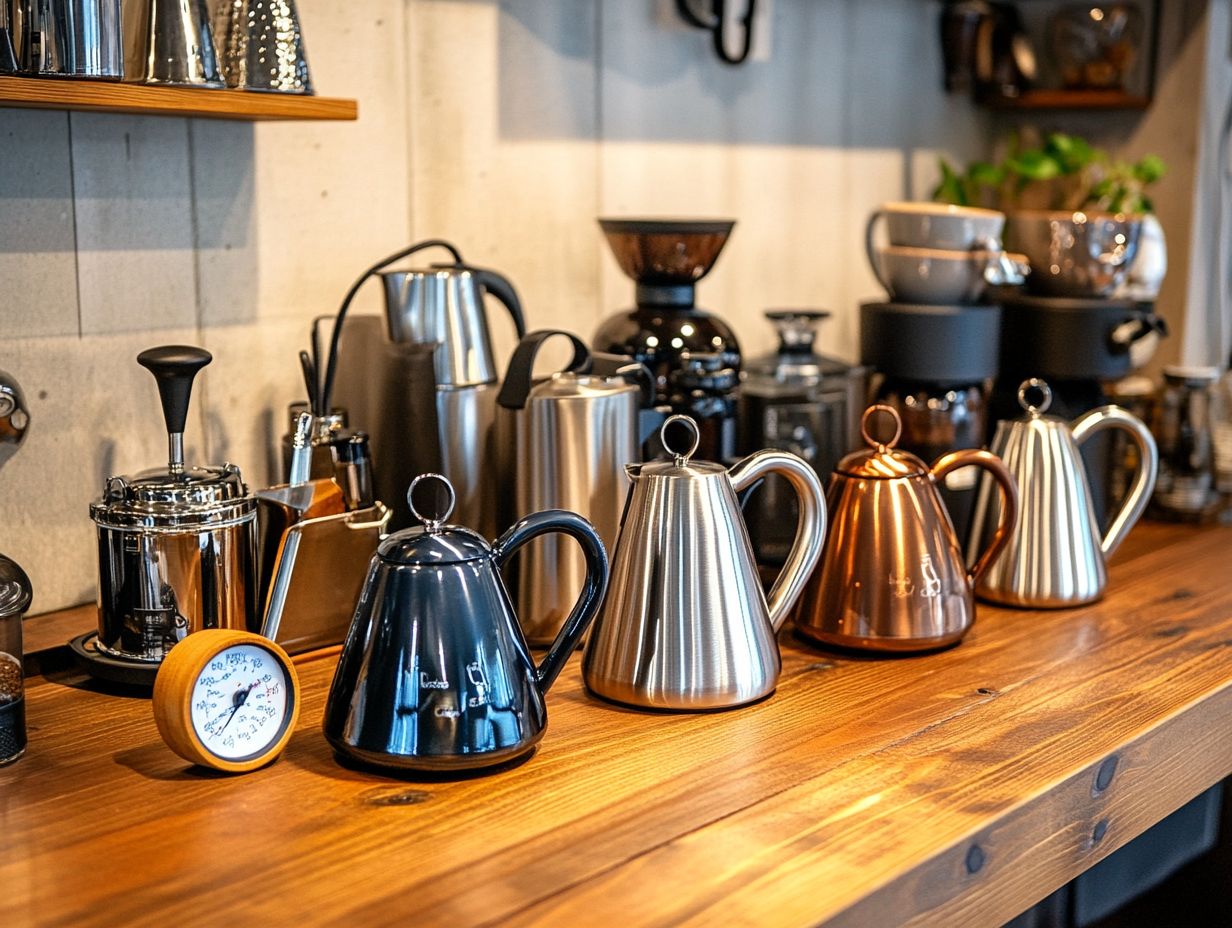
When selecting the perfect brew kettle, you’ll want to consider several key factors that affect the quality and efficiency of your beer brewing. Whether you’re brewing beer, specialty teas, or delicate coffee varieties, these factors remain critical.
The material of the kettle is essential; it plays a significant role in durability and heat distribution. You ll also need to think about the size of the brew kettle, ensuring it matches your brewing volume. Brands like Spike and Br u Supply offer various sizes to match different brewing needs.
It’s wise to assess the maintenance requirements and explore additional features that could elevate your brewing experience think spigot types and temperature control mechanisms. Brands like Spike and Br u Supply provide kettles with built-in thermometers and spigots. These considerations will help you craft the best possible beer with ease and precision.
1. Material
The material of your brew kettle plays a crucial role in shaping its performance, durability, and maintenance requirements. Stainless steel often tops the list for its longevity and ease of cleaning, while aluminum offers a lightweight alternative, though you may want to weigh some durability concerns. Copper, while not as common in modern kettles, boasts impressive heat conductivity, making it a go-to for those who take brewing seriously. Brands like Spike and Br u Supply offer excellent options for each material type.
Each material distinctly influences the brewing process and the results you achieve. For example, stainless steel s resistance to corrosion and scratching ensures your kettle stays in prime condition even after numerous brews, making it a great choice for both novices and seasoned brewers alike. If you need to move your kettle around frequently, aluminum s lightweight nature can be a game changer. Furthermore, copper’s excellent heat distribution makes it ideal for maintaining consistent temperatures during the brewing process.
On the other hand, copper kettles come with their own charm they heat up quickly and look stunning but they demand a bit more attention to prevent tarnishing and need lining to avoid any unwanted chemical reactions with certain ingredients. As a brew enthusiast, it s essential for you to evaluate your specific needs, taking into account your brewing frequency, the type of beer you re crafting, and your willingness to maintain your equipment, before settling on the right kettle material. Whether you are a home brewer or a professional, choosing between stainless steel, aluminum, or copper kettles depends on various factors such as brewing frequency and maintenance.
In conclusion, considering the material, size, maintenance requirements, and additional features will ensure you choose the right brew kettle for your brewing adventures. Happy brewing!
2. Capacity
The capacity of your brew kettle is a crucial element that significantly impacts the volume of beer you can produce in a single batch. By selecting the right brew kettle size, you ensure that you can efficiently boil enough wort (the liquid extracted from the mashing process) to fulfill your brewing ambitions while maintaining the integrity of the wort transfer process. It s important to align your kettle’s capacity with your brewing frequency and the specific requirements of your recipes.
Brew kettles typically come in a variety of sizes, ranging from 2.5 gallons to over 10 gallons. If you re just starting out or prefer brewing smaller batches, a 5-gallon kettle is a perfect choice. On the other hand, if you have aspirations of creating larger batches or scaling up your brewing endeavors, a 10-gallon kettle would ideally suit your needs.
Keep in mind that your batch size directly affects both boil time and efficiency. Using a kettle that s too small might result in unwelcome boil-overs or extended brew days. Properly sizing your kettle also helps maintain a consistent temperature and enhances hop utilization (the process of extracting flavor and aroma from hops), ensuring that your final product achieves the flavor and quality you desire.
3. Heat Source
When selecting a brew kettle, you must consider the significance of the heat source, as it directly impacts both the efficiency and consistency of your brewing process. Whether you choose an electric kettle with features like programmable settings that offer precise control or a traditional stove-top kettle, the heat source plays a crucial role in how quickly you can bring your wort to a boil and maintain the necessary temperature throughout the brewing cycle.
Gas options tend to provide rapid heat-up times and high-temperature output, making them particularly suitable for large batches, especially when brewing outdoors. However, their performance can be a bit unpredictable, influenced by environmental factors like wind or temperature fluctuations.
In contrast, electric kettles bring a level of convenience and consistent heat that ensures fabulous temperature control! While they may require specific electrical setups and can be slower to heat compared to gas, they excel in providing a steady brewing experience.
Your choice of heat source will not only determine the kettle’s performance but also significantly impact overall brewing efficiency, ultimately shaping the quality of the beer you create.
4. Additional Features
Additional features in brewing kettles can truly elevate your brewing experience, providing functionalities that cater to a variety of brewing styles. Imagine having integrated thermometers for precise temperature control, different spigot types that make wort transfer a breeze, and built-in heating elements that streamline your setup and boost efficiency.
With kettles that offer programmable settings, you can automate certain processes like heating cycles, freeing you up to focus on other essential brewing facets while ensuring consistency in your craft. The inclusion of sight glasses allows you to easily monitor liquid levels, reducing the risk of those dreaded overflows or underfills.
Kettles with insulated walls are a game changer, helping you maintain temperature for longer periods while conserving energy. Plus, advanced options like whirlpool ports enhance flavor extraction by promoting more efficient wort circulation.
Each of these features not only enhances usability but also showcases how thoughtful design can transform the brewing process into something truly remarkable. Whether you opt for a Spike kettle or an Unibr u system, having the right kettle features can significantly impact the quality of your beer!
What to Look for in a Good Brewing Kettle?
When you’re on the hunt for the perfect brewing kettle, several key attributes can significantly elevate your home brewing experience.
Key Attributes
Durability is of utmost importance. Choose a kettle that withstands high temperatures and frequent use without breaking a sweat.
Consider heat conductivity, as it is crucial for achieving an even boil nobody wants hot spots ruining their brew.
Look for features that facilitate easy cleaning, saving you precious time and effort after your brewing session. Also, the spigot type can make a significant difference in the efficiency of moving liquid from one container to another during brewing.
Finally, versatility is essential; a kettle that can adapt to various brewing methods and recipes will undoubtedly enrich your brewing journey. Don t miss out on the benefits of high-quality brewing supplies they can truly elevate your craft.
1. Durability
When selecting a brew kettle, durability should be at the forefront of your mind, as it directly affects the longevity and effectiveness of your brewing equipment. Choosing materials like stainless steel ensures that your high-grade kettle can handle the demands of brewing, while aluminum kettles may require a bit more TLC to avoid dents and damage.
Don t underestimate the importance of regular maintenance; it s key to preserving both the durability and functionality of your kettle. The material you choose for your kettle not only impacts its lifespan but also the quality of your brew.
A durable kettle can withstand high temperatures without warping, allowing for consistent heat distribution crucial for extracting those desired flavors during brewing. Keeping your kettle clean and free from residues minimizes the risk of corrosion and ensures optimal brewing conditions.
Here are some maintenance tips to keep in mind:
- Regularly check seals
- Avoid sudden temperature changes
- Use gentle cleaning agents
By treating your kettle with the care it deserves, you can enjoy years of exceptional performance and delightful brews, making it an invaluable addition to your brewing setup. Ensuring proper kettle maintenance is key to longevity.
2. Heat Conductivity

Heat conductivity plays a pivotal role in the efficiency and effectiveness of your brewing kettle during the boiling wort phase. If you’re considering materials, copper stands out for its exceptional heat conductivity, ensuring an even boil, while stainless steel is a reliable option that performs well. Aluminum kettles offer decent conductivity but may fall short in heat retention compared to their counterparts. The choice of kettle material significantly impacts the brewing process.
This variation in heat transfer can significantly influence your brewing process, impacting flavor extraction and overall brew quality. When you opt for high-conductivity materials like copper, you’ll often find that boil times are reduced, and consistency in your final product improves, leading to a cleaner taste profile.
Stainless steel, though somewhat less conductive, has gained a loyal following thanks to its durability and corrosion resistance, making it a practical choice for many brewers. As for aluminum kettles, they might be lightweight and budget-friendly, but they will require your diligent attention to temperature management to achieve optimal brewing conditions.
By understanding these material properties, you can select the most suitable kettle, elevating both your brewing experience and the quality of your craft.
3. Easy to Clean
An easy-to-clean brew kettle elevates your brewing experience, allowing you to focus on the art of crafting quality beer rather than dealing with extensive cleanup afterward. Kettles designed with smooth surfaces and minimal nooks make for quick cleaning post-brew, ensuring that no residues linger to impact your future batches.
Maintaining a pristine brewing setup not only preserves the rich flavors of your beer but also wards off unwanted bacteria and off-flavors that could spoil your hard work. It’s essential to establish a cleaning routine right after each use, employing hot water and a gentle cleanser to eradicate any sticky remnants. Proper kettle maintenance is crucial for longevity.
Regularly inspecting and deep cleaning your kettle will help you catch any scratches or damages that may harbor contaminants. By prioritizing proper kettle maintenance, you cultivate a reliable brewing environment, ensuring that every batch reflects your dedication and passion for the craft.
4. Versatility
Versatility in a brew kettle gives you the power to explore a variety of brewing techniques and recipes, making it an invaluable addition to your brewing equipment collection. A kettle that supports both extract brewing and all-grain brewing greatly expands your brewing possibilities, allowing you to experiment with an array of styles and flavors.
This adaptability means you can smoothly transition from crafting a straightforward batch of classic American ale to creating a complex Belgian-style brew, complete with varying hops and malts.
For example, a kettle equipped with temperature control and the capability for step mashing simplifies the brewing of sophisticated styles like IPAs or stouts. Features such as a built-in thermometer or a sight glass allow you to monitor the brewing process with precision, providing the accuracy you need to perfect your craft. The best brewing kettles come with these advanced features to enhance your brewing experience.
Ultimately, a versatile brew kettle not only fosters your creativity but also elevates the entire brewing experience. Brands like Spike, Br u Supply, and Unibr u offer kettles equipped with various features like HERMS, OG, and built-in heating elements to simplify your brewing setup.
How to Properly Maintain a Brewing Kettle?
Proper maintenance of your brewing kettle is essential for ensuring its longevity and optimal performance. This will enable you to consistently produce high-quality beer. Whether you are a home brewer or a professional, keeping your equipment in top shape is crucial.
Key maintenance practices include conducting a thorough cleaning after each use to eliminate residues and prevent buildup. Alongside proper storage techniques, these practices protect the kettle from potential damage. This is essential regardless of whether you use a stainless steel or an aluminum kettle.
Pay attention to the upkeep of extra features, such as spigots and temperature controls, as these are crucial for maintaining the overall functionality of your brewing setup. Ensure the spigot type matches your needs and that the features of the kettle are in good working order.
1. Regular Cleaning
Regularly cleaning your brewing kettle is not just a chore; it’s essential for preventing off-flavors in your beer and maintaining the integrity of your brewing equipment. After each brewing session, make it a priority to thoroughly clean the kettle to eliminate any remaining beer liquid or hop material.
This is especially important if you are dealing with boiling wort (the liquid extracted from the brewed mash) and wort transfer. This straightforward yet crucial practice not only extends the life of your kettle but also ensures that every batch of beer reaches its full potential in flavor and quality.
Whether you are into extract brewing or all-grain brewing, proper kettle maintenance is key. To clean effectively, start by rinsing the kettle with warm water to wash away loose debris. Then, grab a non-abrasive sponge and a gentle brewery-specific cleaner designed for metal surfaces, carefully following the manufacturer s guidelines.
For aluminum kettles, make sure to avoid harsh chemicals that can damage the surface and lead to aluminum oxide formation. Don t forget to sanitize the kettle with a safe brewing sanitizer to eliminate any lingering bacteria. By consistently following these steps and using safe products, you will preserve the functionality of your kettle and enjoy consistently excellent brewing results.
Investing in a high-grade kettle like those from Spike or Br u Supply can also make a significant difference in your brewing quality.
2. Proper Storage
Storing your brew kettle properly is crucial for protecting it from damage and keeping it in peak condition between your brewing sessions. Ideally, you should place the kettle in a clean, dry area, preferably covered, to shield it from dust and debris that could hinder its performance when you’re ready to brew again.
Proper kettle maintenance includes checking for any signs of wear that could affect the kettle durability. If you’re stacking kettles, it s a smart move to use soft cloths or protective pads in between them to prevent any scratches or dents. Maintaining cleanliness is paramount; make sure to rinse the kettle thoroughly and dry it completely before storage to avoid rust and buildup that can compromise the material over time.
This tip works wonders for both aluminum and stainless steel kettles. Additionally, keeping your kettle in a stable environment with controlled temperatures can significantly enhance its longevity. By adhering to these best practices, you ll boost your kettle’s lifespan, ensuring it consistently delivers outstanding results and remains a dependable companion for all your brewing adventures.
This is particularly important for those using advanced setups like HERMS (Heat Exchange Recirculating Mash System) or Unibr u (a brewing system designed for efficiency).
In conclusion, maintaining your brewing kettle is vital for ensuring exceptional brewing results. By implementing regular cleaning and proper storage practices, you will not only extend the life of your kettle but also enhance your brewing experience. Don t wait act now and apply these tips to keep your brewing kettle in top shape!
3. Maintenance of Additional Features
Maintaining the additional features of your brew kettle, like spigots and temperature controls, is essential for ensuring your brewing equipment runs both efficiently and effectively. Conducting regular checks for leaks in the spigots and verifying that your temperature sensors are working properly can help you sidestep issues during the brewing process, enhancing your overall brewing experience. Complex brewing setups benefit significantly from precise temperature control and accurate thermometers.
A well-maintained brew kettle not only boosts the precision of your brewing but also significantly influences the final flavor profile of your beer. Don t forget to clean the spigots regularly to keep your brew tasting great! Calibrating your temperature controls ensures optimal fermentation conditions. Many experienced brewers trust brands like Spike and Br u Supply for reliable and durable brewing equipment.
By inspecting the kettle’s seals and gaskets, you prevent unwanted air exposure, which preserves the quality of your ingredients. Experienced brewers know that these seemingly minor maintenance tasks directly correlate with the success of their homebrewing endeavors, underscoring the importance of caring for these features. Whether you’re targeting a high OG (original gravity) or aiming for a precise fermentation profile, regular maintenance plays a pivotal role. Regular maintenance not only enhances your brewing experience but also takes your beer to the next level!
Frequently Asked Questions

What factors should I consider when choosing a brewing kettle?
When choosing a brewing kettle, you should consider the size, material, features, and budget. The size should be suitable for the amount of beer you want to brew, the material should be durable and safe for brewing, the features should meet your brewing needs, and the budget should be within your means. Brands like Br u Supply and Spike are known for offering some of the best brewing kettles in the market.
How do I determine the right size of brewing kettle for my needs?
The size of the brewing kettle depends on the batch size of beer you want to brew. A general rule is to have a kettle that is at least 20% larger than the batch size to accommodate any foaming or boiling over. It’s also important to consider the amount of liquid you’ll need for mashing and sparging, which is the process of rinsing the grains to extract fermentable sugars. For larger batches, a 15-20 gallon Tank kettle is often recommended.
What are the main materials used for brewing kettles and which one is best?
The main materials used for brewing kettles are stainless steel, aluminum, and enamel-coated steel. Stainless steel is the most popular choice due to its durability, ease of cleaning, and resistance to corrosion. However, aluminum is a good option for those on a budget, and enamel-coated steel is a good choice for those who prefer a non-reactive material. Copper kettles, although less common, are excellent for heat conductivity.
This guide will help you choose the right brewing kettle by answering common questions.
What features should I look for in a brewing kettle?
When choosing a brewing kettle, consider your brewing setup and specific needs. Important features include a built-in thermometer, a sight glass for monitoring liquid levels, a spigot for easy pouring, and multiple ports for accessories, such as a tool that helps mix the ingredients.
High-end kettles from Spike or Br u Supply offer versatile options for all-grain brewing that can enhance your brewing experience.
Can I use any type of kettle for brewing beer?
Choosing the right kettle is crucial for brewing great beer. Don t settle for just any pot! Use a kettle specifically designed for brewing to ensure the best quality beer and to avoid contamination.
Regular kitchen pots may be made of reactive materials or lack necessary features, making them unsuitable for brewing.
How much should I budget for a brewing kettle?
The cost of a brewing kettle varies greatly based on size, material, and features. A basic 10-gallon stainless steel kettle typically ranges from $100 to $200.
Larger and more advanced kettles can cost up to $500 or more. A high-end kettle from Br u Supply or Spike may cost more but offers better durability and performance.


